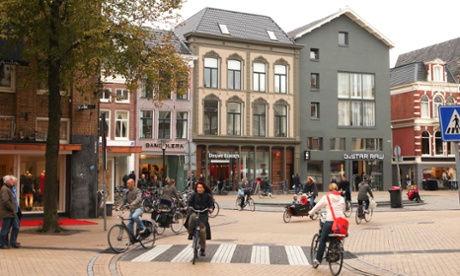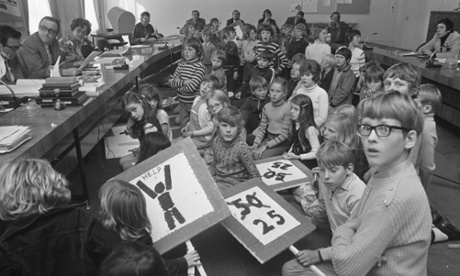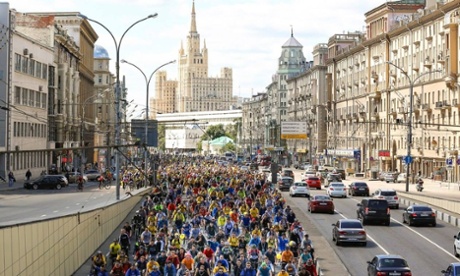Traffic lights with rain sensors to give quicker priority to cyclists on wet days … Heated cycle paths so cyclists won’t slip during bouts of frost … This might sound like science fiction to you, but in the Dutch city of Groningen it will soon be everyday reality.
The inhabitants of this lively northern university city regard their homestead as the cycling capital of the Netherlands. They might very well be right: 61% of all trips in Groningen are made by bicycle, rising to more than 70% for trips made to educational institutions.
You might think the city authorities would be satisfied with these statistics. But apparently it’s not enough, and new plans are in the pipeline to push cycling even more.
Intelligent traffic lights and heated cycle paths are only part of the plan. New “park and bike” areas with bike rental services will emerge on access roads to encourage commuters to leave their cars behind and enter the city by bike. Five thousand new parking places for bikes will be built near the main train station – next to the existing 10,000 that, believe it or not, have proved themselves insufficient. And a “bicycle effect analysis” will be obligatory for each territorial development project to ensure that provisions are made for bikes right from the start. These are just a few of the new, bicycle-friendly measures.
“The bike is the number-one mode of transport in the centre of Groningen,” says local politician Paul de Rook, who rides his bicycle daily to the city hall, “but we have to make an effort to keep it that way, because our population is growing and public space is severely under pressure. We want cycling to really become part of our local pride.”
The city of Groningen has a long history as a trading town and fortress. It boasts canals and ancient warehouses as well as some conspicuous modern architecture. And it has an amazingly young population: almost 18% of its 200,000 inhabitants are students. The young population is one of the reasons why cycling is so popular – along with the mild climate and the absence of hills – but there’s much more to it than that.
The history of Groningen as a bicycle city par excellence goes back to the 1970s, when a left-wing council wanted to make a change. In the 60s, the number of cars was growing rapidly and they were severely clogging up Dutch cities. The common response was to tear down old neighbourhoods and build motorways right through the centre of town. However, in Groningen, local politician Max van den Berg decided on a revolutionary policy. Van den Berg, who was 24 when he became responsible for the city’s traffic and urban development policy, dreamed of expelling cars from the centre and creating space for pedestrians and cyclists. In those days, it was totally unheard of.
“Instead of destroying old neighbourhoods, we wanted to restore them and convert them into pleasant areas for people to live in. The idea was to discourage motorised traffic and to give priority to pedestrians, bikes and public transport,” remembers Van den Berg. “All this was feasible because Groningen is a relatively small, compact city. The distances are short and can easily be covered by foot or by bike.”
When he first revealed his bold intentions, it caused fireworks in the city council. “I was accused of being a problematic administrator. I was under constant attack. Even in my own party there were people who strongly disagreed with me. But, to me, they were just lagging behind. I think it really was a clash between generations.”
In the end, the younger generation won. Four local politicians resigned saying it was impossible to work with Van den Berg. Their successors were very young and very left-wing, and they shared his vision.
The essence of Van den Berg’s traffic circulation plan, as it came to be called, was that the centre of Groningen would be divided in four sections. For motorists, it would become impossible to go from one section to the other: cars had to take the ring-road around the inner city, whereas cyclists could move freely about on new cycle paths constructed to accommodate them. Driving a car would become a time-consuming affair in the centre of Groningen. In the future, travelling by bike would be a much quicker option.
“Many people who lived in the old neighbourhoods were enthusiastic about our ideas. They saw we were changing things on a great scale. But there was also fierce opposition, especially from businessmen and shopkeepers who were convinced it would mean the end of their business if cars could no longer cross the centre. We tried to explain that we wanted to create a pleasant urban environment that eventually would attract more people to the centre and to their shops. But they were convinced they would go bankrupt if customers would not be able reach their shop by car,” says Van den Berg. “In the end, it turned out they were wrong.”
Angry shopkeepers painted slogans on their store windows, collected signatures and demonstrated at the city hall – to no avail. In 1977, the traffic circulation plan was implemented over a single night. Hundreds of new signs were put up to create one-way streets or change their direction. Overnight, the centre of Groningen became impenetrable for cars. The next morning, hostesses greeted confused motorists with flowers and leaflets that explained the new situation.
“We were simply ahead of our time,” says Jacques Wallage who, as the local politician who took over the traffic portfolio from Van den Berg, was responsible for implementing the controversial traffic plan. “In the 70s, the general idea in the Netherlands was that cities needed to adjust to the car. What we wanted was to adjust the car to the city. It was a tough fight. The shopkeepers were livid. I, personally, received threats. People said: ‘We know were you live.’” he adds. “I’ve had a long career in politics – I have been a minister with a politically sensitive portfolio – but [that was] the only time I have needed police protection.’’
After the traffic plan was implemented, new cycle paths were constructed and trees were planted in the centre. The Vismarkt, a central square – which for years had been a huge parking place – regained its historical function as a market. And the much-feared commercial disaster simply didn’t take place. The majority of the shopkeepers survived and some of them even thrived.
Of course, it took some time before motorists got used to the situation and those who don’t know the city still stand a fair chance of getting frustrated. But Groningen now boasts the cleanest air of all big Dutch cities and many streets in the centre are amazingly quiet.
Today, Van den Berg is governor of the province of Groningen. “Our vision was a colourful, compact city,” he says. “We wanted to keep institutions like the hospital and the university in the heart of the city, so people would be able to reach those by bike. The result of this policy is a lively, vibrant city. Groningen attracts more visitors than before, even from outside the province and from Germany. I, myself, live in the centre and I now reap what I once sowed.”
Nowadays, the inhabitants of Groningen possess an average of 1.4 bikes per person. The average number of bikes per household is 3.1. And, while the number of cars is declining, the use of bicycles in the city is still growing. So much so that, according to Wallage, a new discussion has arisen about the predominance of the bike. “There is some tension between pedestrians and cyclists. Cyclists are considered too domineering by some people. There are complaints that they throw down their bikes virtually everywhere and that pedestrians occasionally get run over by cyclists.”
Be that as it may, few people in Groningen seem to doubt that the traffic circulation plan is beneficial. “In the 70s, the plan was seen as an anti-car measure. Now we see it as a pro-bike plan,” says de Rook.
He is now creating cycle paths outside of the city of Groningen, to make it possible to reach neigbouring villages and towns by bike safely and comfortably. And he has launched a new idea: to remove the buses from the city centre and have them use the ring-road in the future, to make even more room for pedestrians and cyclists, and to create more public space with trees and benches. According to de Rook, this means that the bus stops in the centre will have to be moved 200 or 300 yards further away. Interestingly enough, there is hardly any debate about it. Even the shopkeepers seem to think it’s a good idea.
Follow Guardian Cities on Twitter and Facebook and join the discussion











